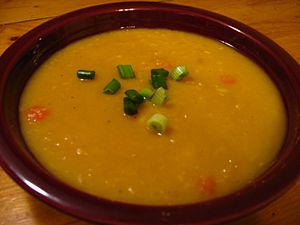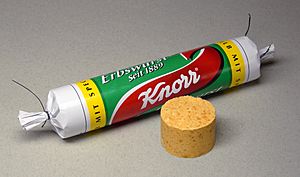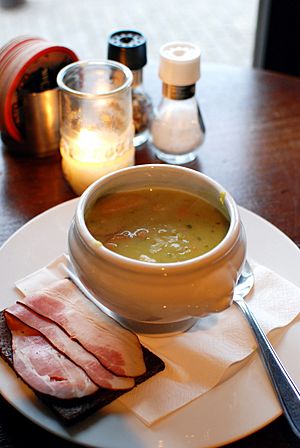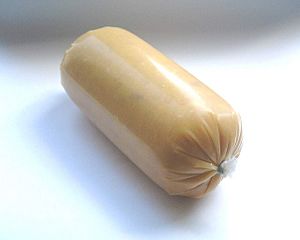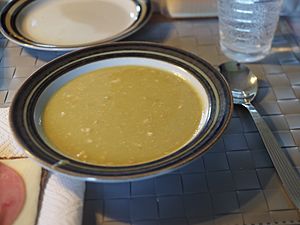Pea soup facts for kids
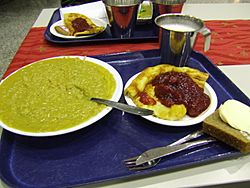
Finnish pea soup and pancakes served by Finnish Defence Forces
|
|
| Alternative names | Split pea soup |
|---|---|
| Type | Soup |
| Place of origin | Ancient Greece or Ancient Rome |
| Main ingredients | Dried peas (split pea) |
Pea soup or split pea soup is a warm, thick soup. It is usually made from dried peas, like split peas. This soup is eaten in many cultures around the world. It can be greyish-green or yellow, depending on the type of peas used. All these peas come from the plant Pisum sativum.
History of Pea Soup
Pea soup has been enjoyed for a very long time. People ate it even in ancient times. It is mentioned in an old Greek play called The Birds. Historians say that ancient Greeks and Romans grew peas around 500 to 400 BC. Back then, street sellers in Athens would sell hot pea soup.
Later, in the 1600s, eating fresh "garden" peas was a new, fancy idea. Before this, peas were mostly dried and used in simple, thick stews. A special soup called Potage Saint-Germain was made with fresh peas and other greens. It was so fancy that it was served to Louis XIV of France, a king, around 1660–1680.
Pea Soup Around the World
Pea Soup in Australia
In Australia, a dish called the Pie floater sometimes includes pea soup.
Pea Soup in Britain and Ireland
An old nursery rhyme from 1765 talks about "Pease pudding hot, Pease pudding cold, Pease pudding in the pot, Nine days old." The word "pease" was the old way to say "pea."
Pease pudding was a common, cheap food that had lots of protein. It was made from dried peas, which could be stored easily. This made it a great food for sailors, especially when boiled with salt pork. Even though potatoes became more popular later, "mushy peas" are still loved today. You often find them served with fish and chips or meat pies.
In the 1800s, pea soup was sometimes seen as a simple food for people who were not rich. For example, in a story by Thackeray, a character is upset because there was "pea-soup for dinner!" at a friend's house, meaning it was not a fancy meal.
A yellow split-pea soup is sometimes called a London particular. This name comes from the thick, yellow smog (fog and smoke) that London used to have before the Clean Air Act 1956.
Pea Soup in Canada
Soupe aux pois (jaunes) (yellow pea soup) is a traditional dish in Québec, Canada. This split pea soup is very popular across the country. It spread from Québec's cooking style.
A common way to make Québec's pea soup is with whole yellow peas, salt pork, and herbs for flavor. After cooking, the pork is often chopped and put back into the soup. In Newfoundland, a similar pea soup is made. It often has more vegetables like diced turnips and carrots. Sometimes, small dumplings called "dough boys" are added on top.
In Newfoundland, split peas are also cooked in a bag as part of a big meal called a Jiggs dinner. This is known as pease pudding.
Pea Soup in Germany
Pea soup is a popular dish all over Germany. It often has meat like bacon or sausage. Sometimes, several sausages are served with the soup, along with dark bread. You can also buy ready-made pea soup in cans.
One of the first instant foods ever made was a pea soup product. It was mostly made from pea meal and beef fat. This product was called Erbswurst (pea sausage). It was invented in 1867 by Johann Heinrich Grüneberg. He sold his recipe to the Prussian government. During the Franco-Prussian War, the army used Erbswurst to feed soldiers. Later, the Knorr company bought the license in 1889. Knorr stopped making Erbswurst on December 31, 2018.
Pea Soup in Indonesia
Indonesia was once a Dutch colony. Because of this, the country adopted some Dutch foods, including pea soup. It is known as sup ercis or erwtensoep there.
Pea Soup in the Netherlands
Erwtensoep, also called snert, is the Dutch version of pea soup. It is a very thick stew. It is made with green split peas, different kinds of pork, celeriac or celery, onions, leeks, carrots, and often potato. Slices of rookworst (smoked sausage) are added before serving. This soup is traditionally eaten in winter and is a symbol of Dutch cuisine.
It is usually served with Frisian rye bread (roggebrood) and bacon, cheese, or butter. The bacon is often katenspek, which is bacon that has been cooked and then smoked. Sometimes, pancakes are served with pea soup. This dish is called snert met struif.
In the Royal Dutch Navy, pea soup is made with small cubes of lard that float on top. Because of this, it is sometimes called Snert met Drijfijs (pea soup with floating ice).
During winter, small food stalls called koek-en-zopie appear along frozen canals in the Netherlands. They serve snert as a warm snack to ice skaters.
In Suriname, which used to be a Dutch colony, Dutch-style pea soup is sold as a street food.
Pea Soup in Nordic Countries
In Scandinavian countries, pea soup is usually cooked with pork. The meat might sometimes be served on the side. A typical recipe also includes onions and herbs like thyme and marjoram.
In Finland, the soup is made with green peas. In Sweden and Denmark, yellow peas are used.
Pea Soup in Sweden and Finland
In Sweden and Finland, the soup is usually served with mustard on the side. People also add extra dried herbs like thyme or marjoram to their soup at the table. After the soup, people often eat pancakes with jam. These pancakes are seen as part of the meal, not just a dessert. In Sweden, the soup is sometimes enjoyed with warm punsch, a type of drink.
People in Sweden and Finland have been eating pea soup since at least the 1200s. It is traditionally served on Thursdays. This custom is thought to come from a time before the Protestant Reformation, when people would eat a filling meal on Thursday to prepare for fasting on Fridays. Eating pea soup on Thursdays is still common in restaurants, schools, and homes.
In Finland, a winter festival called Laskiainen is celebrated by eating green pea soup. People also eat pancakes or a special pastry called laskiaispulla. This celebration often includes downhill sledging.
It is said that the Swedish king Eric XIV (1533–1577) died after eating poisoned pea soup.
Pea Soup in Denmark
In Denmark, pea soup is served with pancakes and mustard. People often scoop up the mustard with rugbrød (rye bread). Sometimes, the dish also includes medisterpølse (a type of sausage), boiled potatoes, and pickled beets. It can be a big feast, with lots of beer and snaps on special days.
In Denmark, this dish has been written about since 1766. However, it might have started as early as the Nordic Bronze Age. Back then, dried peas and cabbage were popular vegetables for the long winters.
Pea Soup in Norway
In Norway, pea soup is traditionally served in springtime and around Easter. It is often served with potatoes, carrots, and other vegetables.
Pea Soup in Poland
In Poland, pea soup is often linked to the military. It is still a popular dish among soldiers. This is because pea soup is healthy, cheap, and easy to make in large amounts. Military pea soup (grochówka wojskowa) is said to be so thick that you can stand a spoon straight up in it! While it's usually made in army kitchens, it's often connected with field kitchens, which are used for cooking outdoors during events.
Pea Soup in the United States
In the United States, "pea soup" usually means a very smooth, pureed soup. An old recipe from 1905 shows it was made with split peas, salt pork, and cold roast beef. The soup was then strained to make it smooth.
"Split Pea Soup" is a bit thinner, with visible peas and pieces of ham. It is especially popular in the Northeast, Midwest, and Pacific Northwest regions. It is also sometimes served as a green-colored food on St. Patrick's Day. For example, a newspaper article from 1919 suggested "Cream of Green Pea Soup (American Style)" for a St. Patrick's Day dinner.
Images for kids
See also
 In Spanish: Sopa de guisantes para niños
In Spanish: Sopa de guisantes para niños


